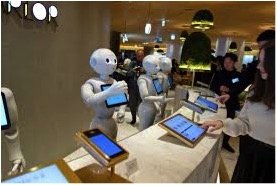Book Review – A World without Work by Daniel Susskind
Daniel Susskind is member of an unusually talented family with a particular focus on the future. Richard, the father, is a known expert, author and speaker on legal technology and the future of the legal profession; Daniel himself, the eldest son, Fellow in Economics and lecturer at Balliol College, has co-authored the book The Future of the Professions with his father and is specialised in the Future of Work; Jamie Susskind, the second son, is a barrister and the author of The Future of Politics; and Alexandra, the youngest and only daughter, studies the intersection between future technology and faith. The conversations on this family’s dinner table must be fascinating.
This time Daniel has decided to go solo and write about his passion for the last ten years, the Future of Work: the result is A World Without Work, a well-researched and well-written book that looks at the issue of automation and job displacement from an economist’s point of view, with an in-depth analysis and diagnosis of the problem, but also with some recommendations and proposals. The book is clear, well-structured and full of interesting anecdotes, references to research and, as it could not be otherwise coming from an economist, full of charts.
The main thesis exposed by Susskind is that, unlike in the past, this time automation is really going to end up producing more and more unemployment, it is not matter of if, but when (he doesn’t say), and we need to get ready for it.
The book is divided in three main parts: the Context, the Threat and the Response. In the first part, the author sets the scene. He tells us about the concept of automation in history and how it has created anxiety at least from the times of Elizabeth I, who when presented with a knitting machine, said “consider thou what the invention could do to my poor subjects. It would assuredly bring to them ruin by depriving them of employment, thus making them beggars”. He introduces the “Age of Labour”, initiated by the Industrial Revolution, and how the entire society, including politics, education and leisure have turned around the concept of work.
The risks of automation and the raise of unemployment have been heralded many times since then, but automation has brought us immense wealth and has created jobs, not destroyed them.
Technology generates two opposing forces regarding jobs, a substituting force destroying them and a complementary force augmenting, enhancing or creating them. This complementary force works by increasing productivity and thus generating value and more jobs, by making the economic pie bigger, creating wealth and creating new jobs that did not exist before, or by changing the pie altogether and spawning new industries (e.g. jobs have been transferred from farming to manufacturing first, then to services and offices). So far, the complementary force has been stronger than the substituting one and that is why we have maintained employment levels despite the exponential growth of technology, but the author believes this is about to end. He explains why in the second part, the Threat.

In the last few decades, a process called polarization or hollowing-out has been happening: new technologies appeared to help high and low skilled workers, but seem to have displaced workers in the middle. Generally well-paid middle-class jobs have been disappearing at an increasing rate. In 2003, MIT economists David Author, Frank Levy and Richard Murnane proposed what it has come to be known as the Author-Levy-Murnane or, simply ALM, hypothesis, which brought two main realisations.
First of all, we should look at tasks and not at jobs, as looking at jobs as fully homogeneous and uniform entities may be misleading; and second, the level of skill required to do a job is not a good predictor of whether that task will be automated or not, but what is instead key is whether a task is routine or non-routine. Routine tasks, understood as those tasks that are easy to explain to a machine, can be automated, non-routine ones not. It seems the middle-skilled jobs of clerks, office administrators and the like had plenty of routine tasks and were therefore easier to automate, than those done by low-skilled workers, working for example in the services industries. The ALM hypothesis has informed most economic thinking on the Future of Work since then and has brought some sort of optimism to the field, as plenty of tasks still left to automate fall into the non-routine category. This, the author believes, is an error.
Susskind explains the concept of Task Encroachment, which basically means that machines will get better and better at what they do in all three capabilities (manual, cognitive and affective) and will increasingly be able to carry out tasks, both routine and non-routine, better than humans, thus replacing us in the workplace. Historically machines have been taking on more and more manual tasks requiring brute force, but in the last decades they have also started being able to carry out more and more cognitive and even affective tasks. This has been enabled by what the author calls the “pragmatist revolution of AI” (as opposed to the “purist” one, as Susskind calls what is better known as the symbolic AI or Good Old-Fashioned AI -GOFAI) or the advent of Machine Learning and its modality Deep Learning, which allows machines to learn and improve upon themselves.
This revolution in AI means that this time is different, and “technological unemployment”, a term coined by Maynard Keynes in the 30s, will really increase, both in its frictional and structural variants.
Frictional technical unemployment happens when there is still some work to do, but for different reasons not all workers seeking employment can take it. The reasons for it are a skills mismatch (when specific skills are required and jobseekers do not have them), identity mismatch (when the jobs available do not match the self-identity of those seeking employment; for example, men unemployed due to automation of manufacturing jobs not wanting to take “pink-collar” jobs or jobs traditionally occupied by women, more difficult to automate, like for example nursing or teaching), or geographical mismatch (jobs exist, but in a particular geographical area and people do not necessarily want to move there).
Structural technological unemployment, on the other hand, is a future in which there is not enough work left for human beings to do, full stop. Susskind analyses each of the factors that have been complementing jobs (productivity, bigger pie and changing pie effects) and his conclusion is that there will be a time when the substituting force of technology will be stronger than the complementary one, thus destroying more jobs than creating them. He does not adventure a timeline, but he believes the march of machines towards performing the tasks that currently human beings do better and cheaper than them is inexorable and will happen in the foreseeable future. His last part is dedicated on what to do about it.

Daniel Susskind held several jobs as policy adviser for the British Government before dedicating his life to academia in economics. If in the first and second parts we were able to see Susskind the economist in action, he left his policy advisor persona for the third and last part, the one dedicated to finding solutions. Like the proverbial owner of a hammer who only sees nails, the author weighs heavily on the State to solve all the problems derived from automation and job loss.
The State should take a bigger part (one of the chapters is called the Big State), rein in “Big tech” on their political ambitions and monopolistic inclinations, invest more in education (although he admits there are limits on what education can achieve when machines are simply better than us on almost everything) and then of course have a more effective and redistributive taxation system, share income and capital amongst its subjects and support labour in this transition. He proposes a variant on the Universal Basic Income, what he calls Conditional Basic Income, as there should be some conditions attached to it to solve, not only the distribution problem, but also the contribution one.
He proposes the creation of different governmental agencies with different purposes (e.g. the Political Power Oversight Authority to constrain the political power of Big tech), but it would be great also to get some ideas on what individuals, companies or other type of non-government organisations could do to mitigate and alleviate the risks of a world without work.
It is an interesting and enjoyable read. The reader will get a well-argued case, based on an economic analysis, of why we may be moving towards a future without work, or considerably less work, and what we should do about it. The economic analysis on the risks of automation is clear, well structured and with plenty of examples and charts. With regards to the solutions part of the book, it is commendable that the author has decided to delve on it and there are some interesting ideas, but all solutions seem to pass for having a bigger State, which is not sure to please all readers.
“A World Without Work” by Daniel Susskind
